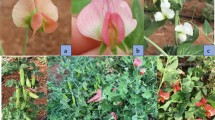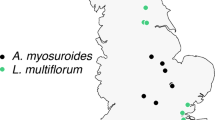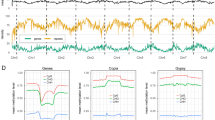Abstract
IN many perennial grasses of temperate regions, exposure to low temperature has proved to be a necessary condition for the attainment of the reproductive phase. After vernalization, flowering may occur directly in response to long-day conditions in some grasses1, or after initial treatment with short days followed by transfer to long photoperiods in others2,3. The precise requirements of timothy grass have so far remained unknown, except that it flowers in long days4 and that spring sowings may lead to ear formation in the same year2. In view of the agronomic importance of the plant, some clarification appeared desirable.
This is a preview of subscription content, access via your institution
Access options
Subscribe to this journal
Receive 51 print issues and online access
$199.00 per year
only $3.90 per issue
Buy this article
- Purchase on SpringerLink
- Instant access to full article PDF
Prices may be subject to local taxes which are calculated during checkout
Similar content being viewed by others
References
Cooper, J. P., J. Ecol., 42, 521 (1954).
Gardner, F. P., and Loomis, W. E., Plant Phys., 28, 201 (1953).
Peterson, M. L., and Loomis, W. E., Plant Phys., 24, 31 (1949).
Evans, M. W., and Allard, H. A., J. Agric. Res., 48, 571 (1934).
Purvis, O. N., and Gregory, F. G., Ann. Bot., N.S., 1, 569 (1937).
Hanson, A. A., and Sprague, V. G., Agron. J., 45, 248 (1953).
Author information
Authors and Affiliations
Rights and permissions
About this article
Cite this article
LANGER, R. Ear Formation in Timothy Grass (Phleum pratense) following Vernalization and Short-day Treatments. Nature 176, 263 (1955). https://doi.org/10.1038/176263a0
Issue date:
DOI: https://doi.org/10.1038/176263a0
This article is cited by
-
Non-Flowering Strains of Herbage Grasses
Nature (1958)



